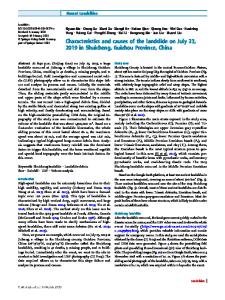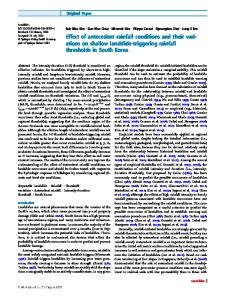The Niushou landslide in Nanjing City, Jiangsu Province of China: a slow-moving landslide triggered by rainfall
- PDF / 8,754,125 Bytes
- 15 Pages / 595.276 x 790.866 pts Page_size
- 54 Downloads / 292 Views
Zinan Li I Faming Zhang I Wen Gu I Menglong Dong
The Niushou landslide in Nanjing City, Jiangsu Province of China: a slow-moving landslide triggered by rainfall
Abstract The Niushou landslide is a slow-moving landslide in the Niushou Mountain cultural tourism area, Nanjing City, Jiangsu Province of China. In June 2015, a tension crack appeared on the south side of Niushou Mountain due to the continuous rainfall, which brought great potential safety risk to the scenic area and the construction of the Alila Hotel. From July 2015 to March 2016, emergency rescue works were used to reinforce the south slope of Niushou Mountain. On June 11, 2016, the Niushou landslide occurred on the south side of Niushou Mountain, caused by the heavy rainfall as a result of the 2015–2016 EI Nino event. The movement of the Niushou landslide caused cracks in the land surface, the buildings of Alila Hotel, and reinforced facilities. Field investigations, drilling holes, geophysical prospecting, laboratory tests, groundwater level monitoring, and surface displacement monitoring were carried out to determine the geological features, deformation characteristics, and failure mechanism. Based on analysis of the monitoring data, the main reason for landslide occurrence was the rise of groundwater level, which increased the uplift pressure offered by confined water and decreased the strength in strongly weathered tuff layer, leading to the sliding surface. The construction land of Alila Hotel has been abandoned until now (May 5, 2020) because of the Niushou landslide. The case discussed how the level of groundwater changes would influence landslide deformation and also provided suggestions for the prevention measures of such landslide. Keywords Slow-moving landslide . Rainfall . Groundwater level change . Mechanism . Prevention measures Introduction Landslides pose a great threat on buildings, infrastructure, and human safety. One of the main triggers for landslide is heavy rainfall (Fourie 1998). Recently, several studies indicate that the intensity and duration of precipitation and the antecedent water content of the landslide mass are the main factors influencing rainfall-triggered landslide (Dang et al. 2019; Hu et al. 2019; Huang et al. 2016, 2018; Shi et al. 2016; Zerathe et al. 2016). Continuous rainfall is necessary to make landslides material saturated and produce pore pressures enough to cause displacement (Bayer et al. 2018). A seasonal variation of water level, caused by seasonal precipitation, determines the speed of landslide movement (Bievre et al. 2018; Cohen-Waeber et al. 2018). What’s more, large changes in precipitation are more sensitive to slow-moving landslides (Handwerger et al. 2019). However, few cases (Hendry et al. 2015) validated the real relationship between landslide
deformation and groundwater level change and discussed uplift pressure offered by confined water below the sliding surface. This study attempted to explore occurrence process and failure mechanism of the Niushou landslide based on the monitored water l
Data Loading...











